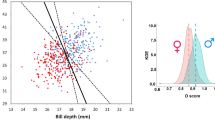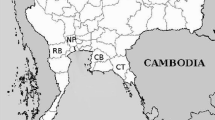Abstract
We analyzed a sample of 173 specimens of different subspecies within the distribution of the Ivory-billed Woodcreeper (Xiphorhynchus flavigaster) in Mexico. Morphological variables were analyzed separately for males, females, juveniles, and adults. The results showed that males were larger in wing chord, tail length, body mass, and primary 8 length than females. Discriminant function analysis yielded correct classification as males or females in 95% of samples analyzed (92.3% of males and 100% of females). Additionally, we identified morphological variables which presented the highest correlation to obtain linear regression functions for estimating one or more missing variables in specimens. The discriminating function developed offers a means of determining the sex of individual Ivory-billed Woodcreepers, so this tool is valuable for ecological studies and population studies of this species.
Similar content being viewed by others
References
Anderson A (1975) A method of sexing moorhens. Wildfowl 26:77–82
AOU (1998) Check-list of North American birds, 7th edn. American Ornithologists’ Union, Washington, DC
Calver MC, Wooller RD (1982) A technique for assessing the taxa, length, dry weight and energy content of the arthropod prey of birds. Aust Wildl Res 9:293–301
Catry P, Phillips RA, Furness RW (1999) Evolution of reversed sexual size dimorphism in skuas and jaegers. Auk 116:158–168
Chapman A, Rosenberg K (1991) Diets of four sympatric Amazonian woodcreepers (Dendrocolaptidae). Condor 93:904–915
Earhart CM, Johnson K (1970) Size dimorphism and food habits of North American owls. Condor 72:251–264
Green P, Theobald C (1989) Sexing birds by discriminant analysis. Ibis 131:442–447
Howell S, Webb S (1995) A guide to the birds of Mexico and northern Central America. Oxford University Press, Oxford
Jenni L, Winkler R (1989) The feather-length of small passerines: a measurement for wing-length in live birds and museum skins. Bird Study 36:1–15
Marantz C, Aleixo A, Bevier L, Patten M (2003) Family Dendrocolaptidae (Woodcreepers). In: del Hoyo J, Elliot A, Christie DA (eds) Handbook of the birds of the world vol 8. Broadbills to tapaculos. Lynx Edicions, Barcelona, pp 358–447
Miller A, Friedmann H, Griscom L, Moore R (1957) Distribution check-list of the birds of Mexico. Part II, Cooper Ornithological Society, Pacific Coast Avifauna 33
Mills AM (2008) Passerines are sexually dimorphic in shape as well as size. Condor 110:354–358
Mullarney K, Svensson L, Zetterström D, Grant PJ (1999) Birds of Europe. Princeton University Press, Princeton, New Jersey
National Geographic Society (1987) Field guide to the birds of North America, 2nd edn. National Geographic Society, Washington, DC
Niizuma Y, Takahashi A, Kuroki M, Watanuki Y (1999) Sexing by external measurements of adult rhinoceros auklets breeding on Teuri Island. Jpn J Ornithol 48:145–150
Norušis M (1988) SPSS/PC+ advanced statistic V2.0. SPSS, Chicago, Illinois
Peterson TR, Chalif E (1989) Aves de México: Guía de campo. Editorial Diana, México
Pierpont N (1986) Interspecific aggresion and the ecology of woodcreepers (Aves: Dendrocolaptidae). PhD dissertation. Princeton University, Princeton, New Jersey
Puebla-Olivares F (2001) Aspectos ecológicos de la familia Dendrocolaptidae en la localidad de Yaxchilán, Chiapas, México. Tesis Maestría, Facultad de Ciencias, UNAM, México
Pyle P (1997) Identification guide to North American birds. Part I: Columbidae to Ploceidae. Slate Creek Press, California
Robbins C, Bruun B, Zim H, Singer A (1983) A guide to field identification of birds of North America. Golden Press, New York
SPSS (2000) SYSTAT 10.0 for Windows. SPSS, Evanston
Svensson L, Mullarney K, Zetterström D, Grant PJ (1999) Collins bird guide. Harper Collins, London
Temeles EJ (1985) Sexual size dimorphism of bird-eating hawks: the effect of prey vulnerability. Am Nat 125:485–499
Vega-Rivera J, Ayala D, Haas C (2003) Home-range size, habitat use, and reproduction of the Ivory-billed Woodcreeper (Xiphorhynchus flavigaster) in dry forest of western Mexico. J Field Ornithol 74:141–151
Weicker JJ, Winker K (2002) Sexual dimorphism in the birds from southern Veracruz, Mexico, and other localities. III. Wilson’s warbler (Wilsonia pusilla). J Field Ornithol 73:62–69
Willis E (1966) Competitive exclusion and the foraging behavior of plain-brown woodcreepers. Ecology 47:667–672
Willis E (1972) The behavior of plain-brown woodcreepers, Dendrocincla fuliginosa. Wilson Bull 81:377–420
Willis E (1982) The behavior of black-banded woodcreepers (Dendrocolaptes picumnus). Condor 84:272–285
Willis E, Oniki Y (1978) Birds and army ants. Annu Rev Ecol Syst 9:243–263
Winker K, Voelker G, Klicka J (1994) A morphometric examination of sexual dimorphism in the Hylophilus, Xenops and an Automolus from southern Veracruz, Mexico. J Field Ornithol 65:307–323
Winker K, Klicka J, Voelker G (1996) Sexual size dimorphism in birds from southern Veracruz, Mexico II. Thryothorus maculipectis and Henocorhina (leucosticta) prostheleuca. J Field Ornithol 67:236–251
Acknowledgments
We wish to thank Alejandro Gordillo and Adolfo Navarro for their comments on initial versions of the manuscript. We thank to Townsend Peterson and Leonardo Chapa for help in reviewing the manuscript. We thank the curators of the following scientific collections: Mayan Biodiversity Museum (MBM), Universidad Autónoma de Campeche; Zoology Museum, Colegio de la Frontera Sur, Unidad Chetumal (MZ-ECOSUR); Zoology Museum “Alfonso L. Herrera”, Facultad de Ciencias (MZFC), Universidad Nacional Autónoma de México, and Colección Nacional, Instituto de Biología, Universidad Nacional Autónoma de México (IBUNAM).
Author information
Authors and Affiliations
Corresponding author
Additional information
Communicated by J. Fjeldså.
Rights and permissions
About this article
Cite this article
Puebla-Olivares, F., Figueroa-Esquivel, E.M. Sexual dimorphism in Ivory-billed Woodcreepers (Xiphorhynchus flavigaster) in Mexico. J Ornithol 150, 755–760 (2009). https://doi.org/10.1007/s10336-009-0394-2
Received:
Revised:
Accepted:
Published:
Issue Date:
DOI: https://doi.org/10.1007/s10336-009-0394-2




